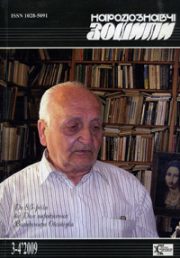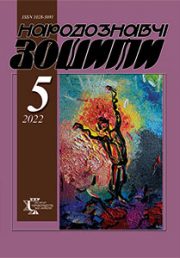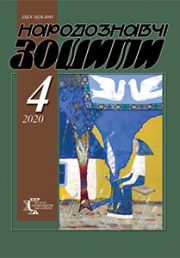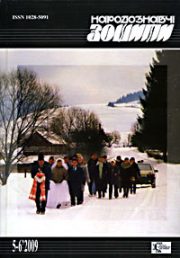The Ethnology Notebooks. 2023. № 3 (171), 542—548
UDK 392.51(477.86/.87+477.83)
DOI https://doi.org/10.15407/nz2023.03.542
PRESENTING BALETS IN THE TRADITIONAL WEDDING CEREMONY OF BOYKOS
HAFYCH Halyna
- ORCID ID: https://orcid.org/0009-0009-5018-5158
- Graduate student, Ivan Franko National University
- Department of Ukrainian folkloristics
- named after Academician Filaret Kolessa
- I University St., 79000, Lviv, Ukraine
- Contacts: e-mail: hakavchyn@gmail.com
Abstract. Ukrainians have always been paying utmost attention to starting a family. Folk morality, customary law, ethical norms and worldview perception formed for years are reflected in the peculiarities of wedding сeremony. Within the time flow wedding rituals have undergone inevitable changes. The Boykos of Sambir district (former Turka district) are not an exception, as the element of tradition at Ukrainian weddings has eventually significantly decreased in the 21st century. However, the wedding tradition of Boyko region saved a lot relic notions. Therefore, the relevance of this article lies in highlighting the ritual of presenting balets that is a relic notion in wedding ceremony and still happens in the western area.
The object of the research is a Boyko wedding ritual of presenting balets and songs that are following it.
The subject is the peculiarities of the ritual of presenting balets exsistance in Western Boyko region and specifics of songs performance during this action.
The source database of current research includes personal field notes made during 2019—2020 in Sambir district (former Turka district) of Lviv region (the same is considered a research novelty) and description of presenting balets to groom’s mother that is mentioned in book of Y. Lozynskyi Russian wedding that was published in Przemysl in 1835 and later republished by R. Kyrchiv with the title Ukrainian wedding.
The methods of research are used in the article are the following cultural, contrastive historical (for understanding the ritual transformation), descriptive, expeditionary (for studying its local features) methods and the method of theoretical generalizations.
Several works of Ukrainian researchers discuss wedding rituals of Boyko region. Separate recordings from this region are included into two volume edition of Wedding, generalized material appeared in collective monigraphy Boyko region, some aspects can be found in historico-ethnografical researches by Borysenko V. Wedding customs and rituals in Ukraine, Marchuk Z. Geneology of Ukrainian wedding, Vovk F. Wedding ritual and customs in Ukraine and others. Several researches are dedicated to Boyko wedding rituals and traditions of separate settlements, in particuar V. Hnatiuk’s Boykos wedding in Mshantsy, Yu. Kmit’s Boyko weedding in Hvizdztsy, Z. Kuzelia’s Boyko wedding in Lavochne, Boyko wedding from village Dovhe in Drohobych district notes by Sokil V. Sokil H. and others.
Modern researches focus their attention in particular on reflection of separate rituals of wedding event. Periwinkle ritual is the most highlighted in works of researchers, it is represented in Boykos wedding culture in particular bright way. Such researchers as L. Bolibrukh, L. Hlavatska, T. Lenio, Z. Sulha. Song materials of Boykos wedding is represented in works of M. Shubravska, O. Pravdiuk, V. Hoshovskyi, P. Zborovskyi, L. Yefremova, however, from the mentioned topic of research inthese works find only separate texts of ladkankas. It is worth highlighting that in scientific literature are saved only mentions about of balets but without detailed description. We managed to find similar ritual that some time was registered by Y. Lozynskyi in the book Russian wedding that was published in 1835 in Przemysl. The significance of this work is very high as for scientific point of view of that tine and for modern too.
Keywords: wedding ceremony, the ritual of presenting balets, wedding folklore, Boyko region, ladkanka, kolomyika, the Matrons of Honor, national cultural heritage.
Received 8.05.2023
REFERENCES
- Shubravska, M.M., & Pravdiuk, O.A. (1970). Wedding: in 2 volumes. Kyiv: Naukova dumka [in Ukrainian].
- Boltarovych, Z.Ye., Budzan, A.F., & Harasymchuk, R.P. (1983). Boyko region: Historico-ethnografical research. Kyiv [in Ukrainian].
- Vovk, F. (1995). Wedding ritual and customs in Ukraine. The studies of Ukrainian ethnography and antropology. Kyiv: Mystetstvo [in Ukrainian].
- Borysenko, V. (1988). Wedding customs and rituals in Ukraine. Kyiv: Naukova dumka [in Ukrainian].
- Marchuk, Z. (2006). Geneology of Ukrainian wedding. Lutsk [in Ukrainian].
- Hnatiuk, Volodymyr. (1908). Boykos wedding in Mshantsy (Starosambir district). Materials for Ukrainian- Rus ethnology (Pp. 1—29). Lviv [in Ukrainian].
- Kmit, Yurii. (1908). Boyko weedding in Hvizdztsy (Turka district). Materials for Ukrainian- Rus ethnology (Pp. 82—100). Lviv [in Ukrainian].
- Kuzelia, Zenon. (1908). Boyko wedding in Lavochne (Stryi district). Materials for Ukrainian-Rus ethnology (Pp. 121—150). Lviv [in Ukrainian].
- Levynskyi, V. (1908). Boyko wedding in Dobrohostov (Drohobych district). Materials for Ukrainian-Rus ethnology (Vol. X, pp. 101—120). Lviv [in Ukrainian].
- Sokil, V., & Sokil, H. (2014). Boyko wedding from village Dovhe in Drohobych district. The Ethnology notebooks, 4, 801—816 [in Ukrainian].
- Bolibrukh, Lina. (2008). Periwinkle ritual in a wedding ceremony in Bohorodchany. (According to ethnographical materials of the expedition in 2008). The Ethnology notebooks, 3— 4, 309—313 [in Ukrainian].
- Hlavatska, Liudmyla. (2010). Periwinkle ritual as one of the main elements of a traditional wedding in the eastern Boyko region (Rozhniativ). Wedding ceremony within time and space: the materials of international scientific conference «Odesa ethnographical readings» (Pp. 8—25). Odesa [in Ukrainian].
- Lenio, Taisia. (2013). Boyko-Transkarpatian periwinkle ritual of the middle of 20th century (according to expedition materials). Folklore and ethnology, 1, 27—32 [in Ukrainian].
- Shulha, Z. (2009). To marriage. Ukranian wedding ceremony acting. Lviv: Apiori [in Ukrainian].
- Hoshovskyi, B. (1971). At the origins of Slavic people folk music. Moskow [in Russian].
- Zborovskyi, P. (2002). Boyko wedding ladkankas. Lviv [in Ukrainian].
- Yefremova, L. (2006). The tunes of Ukrainian wedding songs. Kyiv: Naukova dumka [in Ukrainian].
- Lozynskyi, Y., & Kyrchiv, R. (1992). Ukrainian wedding (Pp. 145—155). Kyiv: Naukova dumka [in Ukrainian].
- Hnatiuk, V. (1966). Selected articles about folklore. Foreword to collection Kolomyiky (P. 158). Kyiv [in Ukrainian].
- Kuziv, I. (1882). Life-being, traditions and customs of mountain people. Zoria (Pp. 70—102). Lviv [in Ukrainian].







